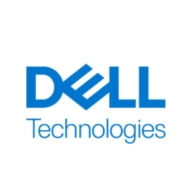

DataCore SANsymphony and VxRail compete in the storage and hyper-converged infrastructure categories, respectively. Based on feature sets, DataCore SANsymphony has an edge in flexibility and compatibility, while VxRail integrates seamlessly with VMware, boosting its performance in virtual environments.
Features: DataCore SANsymphony offers redundancy, continuous data protection, and flexibility in utilizing various storage types, facilitating both cost savings and easy upgrades. VxRail, on the other hand, provides seamless VMware integration, high performance through its hyper-converged infrastructure, and robust manageability features.
Room for Improvement: DataCore SANsymphony users suggest enhancements in the interface, report generation, and a more integrated global monitoring feature. VxRail is noted to benefit from a simplified deployment process and pricing adjustments, especially for smaller organizations, as well as improved support for node additions.
Ease of Deployment and Customer Service: DataCore SANsymphony is known for its straightforward installation process and excellent technical support. VxRail, while effective in on-premises deployment, has a more complex setup due to its comprehensive integration but is backed by strong customer and technical service.
Pricing and ROI: DataCore SANsymphony's costs are influenced by licensing models and hardware dependencies, yet it offers good value through flexible options. VxRail is considered expensive, particularly for smaller enterprises, but offers comprehensive integration and support which some users find cost-effective over time. Both solutions promise high ROI potential, varying primarily in their cost structure and target market.
They always help me quickly and with great knowledge, which is essential for central storage.
I would rate technical support from DataCore SANsymphony a 10.
The customer support is perfect.
A key area for improvement for VMware would be response time.
The support is all provided by Dell, and it is quite good.
There are no limits to scalability, which is essential for central storage.
There are limitations, such as the inability to upgrade from a single to dual CPU in certain configurations.
Scalability is easy with VxRail.
It is a very stable and mature product, with centralized management and upgrades being perfect for us.
The product is very stable, and I rate its stability as nine out of ten.
there should be improvements in how to get and filter logs
DataCore SANsymphony can be improved with high availability as it offers synchronous mirroring between physical and separate sites to ensure business continuity and disaster recovery.
The area of DataCore SANsymphony that has room for improvement is the support.
It requires a very clean environment to proceed without issues.
The major issue with VxRail is the razoring process, which can only be performed by Dell.
Stabilizing the update procedure further would make it better.
They have made some improvements regarding the pricing, but it's still too expensive.
The cost changed from a perpetual license to a subscription model.
Purchasing VxRail is quite expensive compared to a simple Dell server.
Previously, the cost was higher, however, recent changes in VMware pricing have reduced it.
The cost varies for us as a large company because we receive special offers from Dell.
Customers can extend storage with flexibility, as one is not obligated to purchase hard disks or controllers from the same storage vendor.
DataCore SANsymphony has positively impacted our organization because it is scalable and has a fundamental concept that aggregates and pools available storage resources, hiding the complexity, which makes it very simple.
DataCore SANsymphony's ability to enhance storage utilization is very good because it's agnostic and it can be deployed on every environment, which is perfect for my clients.
Customers prefer the single pane of glass management and integration with VMware, which makes it easier for them to proceed with decisions involving VMware products.
Another benefit is the fully automated upgrade process, which is completed with just one click through the VxRail Manager.
The features of VxRail that we find most useful for our customers include the easy update mechanism and the support for both VMware and hardware.
| Product | Market Share (%) |
|---|---|
| VxRail | 14.9% |
| DataCore SANsymphony | 2.5% |
| Other | 82.6% |


| Company Size | Count |
|---|---|
| Small Business | 36 |
| Midsize Enterprise | 12 |
| Large Enterprise | 21 |
| Company Size | Count |
|---|---|
| Small Business | 42 |
| Midsize Enterprise | 42 |
| Large Enterprise | 56 |
Experience peace of mind with DataCore SANsymphony, the ultimate software-defined storage solution alleviating storage management challenges. Say goodbye to the complexities of managing different storage tiers and disruptions with SANsymphony's block-level storage virtualization technology, empowering you to automate capacity provisioning and data placement across diverse storage environments including SAN, DAS, HCI, and JBOD. Break down silos, control data placement, meet business continuity objectives, boost performance, and seamlessly expand or refresh hardware with SANsymphony. Benefit from features like asynchronous replication for disaster recovery, minimizing data loss, accelerating application responsiveness, and integrating new technology non-disruptively. Trusted by industry leaders like NASA, Thorntons, Inc., and TUI Cruises, DataCore SANsymphony guarantees unparalleled flexibility, scalability, and reliability, ensuring uninterrupted data access and application availability while reducing storage costs and inefficiencies.
VxRail is a hyper-converged infrastructure appliance co-engineered by Dell Technologies and VMware, designed to optimize VMware environments by simplifying compute, storage, virtualization, and management.
Built on VMware vSAN software, VxRail ensures high performance, reliability, and flexibility. It supports a broad array of workloads, from business-critical applications to next-generation use cases. VxRail simplifies infrastructure management with powerful integration and seamless scalability, offering centralized management and user-friendly interfaces. Streamlined updates, robust lifecycle management, and one-click upgrades facilitate a user-centric experience that minimizes deployment complexity and staffing needs. However, its performance with disk deduplication, integration with public clouds, and processor support can be enhanced, along with pricing and licensing improvements.
What features define VxRail?Organizations across sectors such as finance, telecommunications, education, and manufacturing utilize VxRail for its scalability, ease of deployment, and infrastructure management capabilities. It aids in server and application hosting, storage, and virtualization management, often employing VMware integration. The platform is valued for its ability to consolidate IT components, support VDI solutions, and enhance cloud readiness and resource allocation.
We monitor all HCI reviews to prevent fraudulent reviews and keep review quality high. We do not post reviews by company employees or direct competitors. We validate each review for authenticity via cross-reference with LinkedIn, and personal follow-up with the reviewer when necessary.